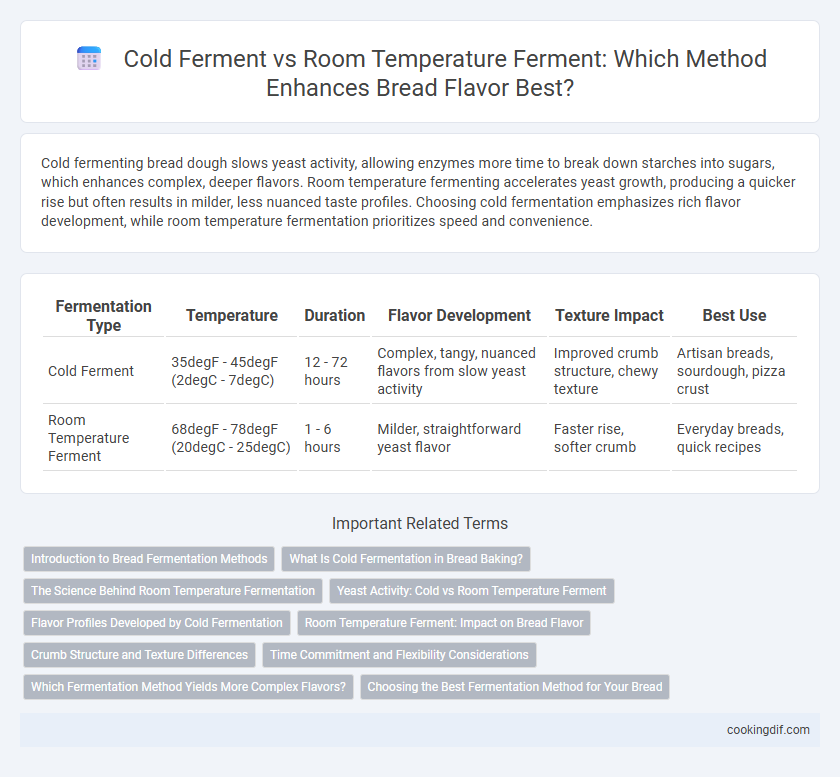Cold fermenting bread dough slows yeast activity, allowing enzymes more time to break down starches into sugars, which enhances complex, deeper flavors. Room temperature fermenting accelerates yeast growth, producing a quicker rise but often results in milder, less nuanced taste profiles. Choosing cold fermentation emphasizes rich flavor development, while room temperature fermentation prioritizes speed and convenience.
Table of Comparison
| Fermentation Type | Temperature | Duration | Flavor Development | Texture Impact | Best Use |
|---|---|---|---|---|---|
| Cold Ferment | 35degF - 45degF (2degC - 7degC) | 12 - 72 hours | Complex, tangy, nuanced flavors from slow yeast activity | Improved crumb structure, chewy texture | Artisan breads, sourdough, pizza crust |
| Room Temperature Ferment | 68degF - 78degF (20degC - 25degC) | 1 - 6 hours | Milder, straightforward yeast flavor | Faster rise, softer crumb | Everyday breads, quick recipes |
Introduction to Bread Fermentation Methods
Cold fermentation slows yeast activity by maintaining dough at temperatures between 35degF and 45degF, allowing complex flavor compounds and organic acids to develop over 12 to 72 hours. Room temperature fermentation, typically conducted around 70degF to 75degF, accelerates yeast growth and results in faster proofing within 1 to 3 hours but produces milder flavor profiles. Both methods influence dough texture, aroma, and crumb structure, with cold fermentation emphasizing enhanced depth of flavor and improved shelf life.
What Is Cold Fermentation in Bread Baking?
Cold fermentation in bread baking is a method where dough is allowed to rise slowly in a refrigerated environment, typically between 35degF and 45degF (1.6degC to 7.2degC), over an extended period ranging from 12 to 72 hours. This slow, controlled fermentation enhances flavor complexity by allowing yeast and bacteria to produce organic acids and alcohols, resulting in a richer, tangier taste and improved crumb structure. Compared to room temperature fermentation, cold fermentation develops deeper, more nuanced flavors while improving dough handling and texture.
The Science Behind Room Temperature Fermentation
Room temperature fermentation accelerates yeast activity, producing higher levels of carbon dioxide and organic acids that enhance crumb texture and flavor complexity in bread. The enzymatic reactions during this process break down starches into simpler sugars, feeding yeast more efficiently and generating a robust aroma profile. Controlled temperature environments optimize gluten development and fermentation rate, resulting in bread with a balanced tanginess and improved crust coloration.
Yeast Activity: Cold vs Room Temperature Ferment
Cold ferment slows yeast activity, allowing enzymes more time to break down starches and proteins, resulting in complex, tangy flavors and a chewier texture. Room temperature ferment accelerates yeast metabolism, producing a faster rise with more yeasty, slightly sweet flavor notes but less depth. Balancing fermentation temperature controls yeast byproducts, influencing bread flavor profiles and crumb structure.
Flavor Profiles Developed by Cold Fermentation
Cold fermentation enhances the flavor profile of bread by allowing yeast and enzymes to work slowly, producing complex, tangy, and mildly sweet notes. Extended cold fermentation encourages lactic acid bacteria activity, resulting in richer, deeper flavors and improved crust texture. This method develops a more nuanced and aromatic loaf compared to quicker room temperature fermentation processes.
Room Temperature Ferment: Impact on Bread Flavor
Room temperature fermentation accelerates yeast activity, enhancing the production of esters and organic acids that contribute to a richer, more complex bread flavor. This process typically takes 2 to 4 hours, allowing gluten to develop and sugars to caramelize during baking, resulting in a slightly tangy and aromatic crust. Compared to cold fermentation, room temperature ferment produces a more pronounced yeasty taste and softer crumb texture, favored in artisanal breads requiring shorter proofing times.
Crumb Structure and Texture Differences
Cold fermentation in bread-making slows yeast activity, allowing enzymes to break down starches and proteins more thoroughly, resulting in a more complex flavor and a tighter, more uniform crumb structure with a chewy texture. Room temperature fermentation accelerates yeast activity, producing a lighter, airier crumb with larger, irregular holes and a softer texture but less depth of flavor. Choosing cold ferment enhances crust development and chewiness, while room temperature ferment emphasizes speed and tenderness in the bread.
Time Commitment and Flexibility Considerations
Cold fermenting dough requires extended time, typically 12 to 72 hours, allowing slow yeast activity that enhances complex flavors and improves texture. Room temperature fermenting takes 1 to 3 hours, offering immediate results but with less depth in taste development. Choosing between these methods depends on your baking schedule flexibility and willingness to plan ahead for rich, nuanced bread flavors.
Which Fermentation Method Yields More Complex Flavors?
Cold fermenting bread dough at temperatures between 35degF and 45degF allows yeast to develop more intricate flavor compounds over an extended period, often 12 to 72 hours, resulting in richer, tangier, and nuanced profiles compared to room temperature fermenting. Room temperature fermentation, typically conducted around 70degF to 75degF, speeds up yeast activity but limits the depth and complexity of flavor development due to the shorter fermentation time, usually 1 to 3 hours. Bakers seeking more complex, artisan-style flavors often prefer cold fermentation to enhance organic acids and aromatic esters that contribute to the bread's character.
Choosing the Best Fermentation Method for Your Bread
Cold ferment accelerates flavor complexity by allowing yeast to work slowly at temperatures between 35-45degF over 12-72 hours, enhancing acidity and depth in sourdough and artisan breads. Room temperature fermenting, occurring around 70-75degF, produces faster yeast activity in 2-4 hours, resulting in milder flavors with less pronounced tang and aroma development. Choosing between cold and room temperature ferment depends on desired taste profiles, baking schedules, and dough handling preferences to optimize texture and flavor intensity.
Cold Ferment vs Room Temperature Ferment for flavor development Infographic

 cookingdif.com
cookingdif.com